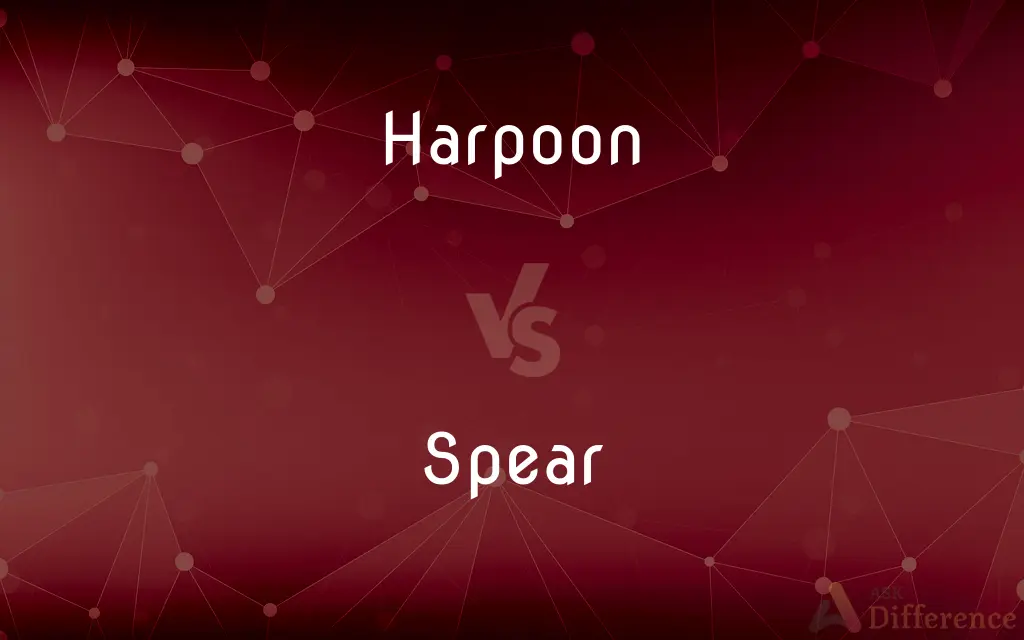Harpoon vs. Spear — What's the Difference?
By Tayyaba Rehman & Fiza Rafique — Updated on March 26, 2024
Harpoon is a specialized tool for hunting large sea animals, featuring barbs to secure catches, while Spear is a versatile weapon used for thrusting or throwing at targets.

Difference Between Harpoon and Spear
Table of Contents
ADVERTISEMENT
Key Differences
A "harpoon" is designed specifically for marine hunting, equipped with barbs to prevent prey from escaping once impaled. It is often used in hunting large sea animals like whales and seals. In contrast, a "spear" is a long, pointed weapon used since ancient times for hunting and combat. It consists of a shaft with a sharp tip, designed for thrusting or throwing at a target.
Harpoons are typically used from boats and can be attached to ropes, allowing hunters to capture and retain large marine animals after striking. This mechanism is crucial for securing animals in the vast and open sea. On the other hand, spears are used for a wider range of purposes, including hunting smaller game, combat, and as a tool in various cultural rituals. Spears can be thrown or used to stab, offering versatility in different scenarios.
The design of a harpoon is such that its barbs dig into the flesh of the catch, ensuring that the prey cannot easily escape once struck. This is particularly important for marine hunting, where the animal could otherwise swim away. Whereas, the design of a spear is focused on penetration and ease of use, whether in hand-to-hand combat or hunting terrestrial animals.
Harpoons often have a mechanism or design feature (like detachable heads attached to a rope) that allows the hunter to pull the captured animal towards the boat or shore. Spears, while sometimes used with ropes in traditional settings, are generally not designed with retrieval in mind, emphasizing immediate lethality or injury.
The cultural significance of harpoons is closely tied to maritime communities and their traditions of sea hunting and fishing. Spears, being more universally found across various cultures, have a broader range of cultural and historical significance, symbolizing warfare, survival, and the skill of the hunter or warrior.
ADVERTISEMENT
Comparison Chart
Purpose
Hunting large sea animals
Hunting, combat, and cultural use
Design
Equipped with barbs for secure catch
Long shaft with a sharp tip
Usage
Attached to ropes, used from boats
Thrown or used for thrusting
Mechanism
Barbs and sometimes detachable heads
Primarily penetration focused
Cultural Significance
Maritime hunting traditions
Broad, including warfare and survival
Compare with Definitions
Harpoon
A tool for marine hunting with barbs.
The fisherman used a harpoon to secure the large tuna.
Spear
Used for hunting and combat.
Spears were thrown at the charging enemy.
Harpoon
Often attached to a rope.
After harpooning the seal, he pulled it in using the attached rope.
Spear
A versatile weapon with a sharp tip.
The warrior carried a spear as his primary weapon.
Harpoon
Used in maritime communities.
Inuit hunters traditionally use harpoons for hunting seals.
Spear
Can be used in various cultural rituals.
The ceremony included a traditional dance with spears.
Harpoon
Designed to prevent prey from escaping.
Harpoons have barbed tips to ensure the whale doesn't slip away.
Spear
Symbolizes warfare and survival.
The spear is a symbol of ancient warfare techniques.
Harpoon
A harpoon is a long spear-like instrument and tool used in fishing, whaling, sealing, and other marine hunting to catch large fish or marine mammals such as whales. It accomplishes this task by impaling the target animal and securing it with barb or toggling claws, allowing the fishermen to use a rope or chain attached to the projectile to catch the animal.
Spear
A spear is a pole weapon consisting of a shaft, usually of wood, with a pointed head. The head may be simply the sharpened end of the shaft itself, as is the case with fire hardened spears, or it may be made of a more durable material fastened to the shaft, such as bone, flint, obsidian, iron, steel, or bronze (or other type of stone or metal).
Harpoon
A barbed spear attached to a rope and thrown or fired from a gun, used especially in whaling.
Spear
A weapon with a pointed tip, typically of steel, and a long shaft, used for thrusting or throwing.
Harpoon
To strike, kill, or capture with or as if with a harpoon.
Spear
A plant shoot, especially a pointed stem of asparagus or broccoli
Smoked salmon wrapped around asparagus spears
Harpoon
A spearlike weapon with a barbed head used in hunting whales and large fish.
Spear
Pierce or strike with a spear or other pointed object
She speared her last chip with her fork
Harpoon
(slang) A harmonica.
Spear
A weapon consisting of a long shaft with a sharply pointed end.
Harpoon
(transitive) To shoot something with a harpoon.
Spear
A shaft with a sharp point and barbs for spearing fish.
Harpoon
A spear or javelin used to strike and kill large fish, as whales; a harping iron. It consists of a long shank, with a broad, flat, triangular head, sharpened at both edges, and is thrown by hand, or discharged from a gun.
Spear
A soldier armed with a spear.
Harpoon
To strike, catch, or kill with a harpoon.
Spear
A slender stalk, as of asparagus.
Harpoon
A spear with a shaft and barbed point for throwing; used for catching large fish or whales; a strong line is attached to it
Spear
To pierce with a spear or other sharp object.
Spear
To catch with a thrust of the arm
Spear a grounder.
Spear
(Football) To block (an opponent) by ramming with the helmet, in violation of the rules.
Spear
(Sports) To jab (an opponent) with the blade of a hockey stick, in violation of the rules.
Spear
To stab at something with a spear or other sharp object.
Spear
To sprout like a spear.
Spear
A long stick with a sharp tip used as a weapon for throwing or thrusting, or anything used to make a thrusting motion.
Spear
A soldier armed with such a weapon; a spearman.
Spear
A lance with barbed prongs, used by fishermen to retrieve fish.
Spear
(ice hockey) An illegal maneuver using the end of a hockey stick to strike into another hockey player.
Spear
(wrestling) In professional wrestling, a running tackle in which the wrestler's shoulder is driven into the opponent's midsection.
Spear
A shoot, as of grass; a spire.
Spear
The feather of a horse.
Spear
The rod to which the bucket, or plunger, of a pump is attached; a pump rod.
Spear
A long, thin strip from a vegetable.
Asparagus and broccoli spears
Spear
(botany) The sprout of a plant, stalk
Spear
(obsolete) A church spire.
Spear
(transitive) To pierce with a spear.
Spear
To penetrate or strike with, or as if with, any long narrow object; to make a thrusting motion that catches an object on the tip of a long device.
Spear
(gridiron football) To tackle an opponent by ramming into them with one's helmet.
Spear
(intransitive) To shoot into a long stem, as some plants do.
Spear
To ignore as a social snub.
Spear
Male.
A spear counterpart
Spear
Pertaining to male family members.
The spear side of the family
Spear
A long, pointed weapon, used in war and hunting, by thrusting or throwing; a weapon with a long shaft and a sharp head or blade; a lance.
They shall beat their swords into plowshares, and their spears into pruning hooks.
Spear
Fig.: A spearman.
Spear
A sharp-pointed instrument with barbs, used for stabbing fish and other animals.
Spear
A shoot, as of grass; a spire.
Spear
The rod to which the bucket, or plunger, of a pump is attached; a pump rod.
Spear
To pierce with a spear; to kill with a spear; as, to spear a fish.
Spear
To shoot into a long stem, as some plants. See Spire.
Spear
A long pointed rod used as a weapon
Spear
An implement with a shaft and barbed point used for catching fish
Spear
Pierce with a spear;
Spear fish
Common Curiosities
Are harpoons used for purposes other than hunting?
Harpoons are primarily designed for hunting large marine animals. Their use outside of this context is limited due to their specialized design.
How has the use of spears evolved over time?
Spears have been used throughout human history for hunting, combat, and as a tool in cultural rituals. Their use has evolved from simple hand-thrown weapons to more sophisticated designs, including those used for sport in modern times.
What makes a harpoon different from a spear in terms of design?
A harpoon is designed with barbs to catch and hold large sea animals, often attached to a rope, while a spear has a sharp point for thrusting or throwing, with emphasis on penetration.
Can spears be used in marine hunting like harpoons?
While spears can be used for fishing and hunting smaller aquatic animals, harpoons are specifically designed for large sea animals, offering features like barbs and ropes for retrieval.
How are spears used in modern sports?
Spears, or javelins, are used in modern athletics as part of the javelin throw event, which tests the athlete's ability to throw it as far as possible.
How do the materials used in harpoons and spears differ?
Historically, both were made from materials like wood and stone, but modern versions may use metals and synthetic materials for improved durability and effectiveness. The specific materials can vary based on the intended use and cultural context.
Do modern hunters still use harpoons and spears?
Yes, in certain cultures and contexts, both harpoons and spears are still used. Harpoons are employed in regulated marine hunting, while spears can be used in traditional hunting practices, sport, and cultural rituals.
What is the significance of the barbs on a harpoon?
The barbs on a harpoon are crucial for ensuring that once the target is struck, the weapon cannot easily be dislodged, securing the catch in the challenging marine environment.
Can harpoons be used for self-defense?
While not designed for self-defense, in emergency situations at sea, a harpoon could theoretically be used as a defensive tool against marine predators.
Is there a difference in skill required to use harpoons vs. spears?
Both weapons require skill and practice to use effectively, with harpooning necessitating knowledge of marine animal behavior and boat handling, while spear usage demands accuracy and, in some cases, physical strength for throwing.
How do modern harpoons differ from their historical counterparts?
Modern harpoons often incorporate advanced materials for strength and durability, and some feature sophisticated mechanisms for improved accuracy and efficiency in marine hunting.
How is spear fishing different from other types of fishing?
Spearfishing involves hunting fish underwater with a spear or speargun, requiring skills in swimming, diving, and accuracy, offering a more selective and environmentally friendly method compared to some modern fishing techniques.
What materials are commonly used to make spears today?
Modern spears for sports, recreation, or ceremonial use are often made from materials like aluminum, carbon fiber, and steel for the tip, offering strength and durability.
What is the range of a thrown spear?
The range of a thrown spear can vary, typically up to 20-30 meters for an average person, but much farther with training and specialized throwing techniques like those used with atlatls.
Can a spear be effective against larger predators?
Yes, a spear can be effective against larger predators, offering the user a longer reach and the ability to deliver a lethal blow from a safer distance compared to hand-to-hand combat.
Are there legal restrictions on using harpoons?
Yes, there are legal restrictions on using harpoons, particularly for hunting protected species like whales. These regulations vary by country and are subject to international treaties.
How do you maintain a harpoon?
Maintaining a harpoon involves regular cleaning to prevent rust and corrosion, sharpening the barbs, and checking the rope and mechanism for wear and tear.
Share Your Discovery

Previous Comparison
Reformation vs. Transformation
Next Comparison
Litter vs. SedanAuthor Spotlight
Written by
Tayyaba RehmanTayyaba Rehman is a distinguished writer, currently serving as a primary contributor to askdifference.com. As a researcher in semantics and etymology, Tayyaba's passion for the complexity of languages and their distinctions has found a perfect home on the platform. Tayyaba delves into the intricacies of language, distinguishing between commonly confused words and phrases, thereby providing clarity for readers worldwide.
Co-written by
Fiza RafiqueFiza Rafique is a skilled content writer at AskDifference.com, where she meticulously refines and enhances written pieces. Drawing from her vast editorial expertise, Fiza ensures clarity, accuracy, and precision in every article. Passionate about language, she continually seeks to elevate the quality of content for readers worldwide.














































